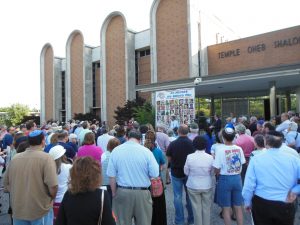JMORE magazine reflects mosaic of ‘big-tent Judaism’
Alan Feiler (left), JMORE’s editor in chief, goes over a story with Simone Ellin, associate editor, at the publication’s offices inside a converted church in Hampden. (Courtesy Photo)
Scott Rifkin, Owings Mills physician, serial entrepreneur, and CEO and founder of Mid-Atlantic Health Care, lost a 2012 bidding war for the bankrupt publisher of the venerable Baltimore Jewish Times.
But Rifkin never gave up his publishing ambitions, and the sale of the weekly Jewish Times to the D.C.-area publisher of Washington Jewish Week has gnawed at him ever since. A local Jewish publication, Rifkin says, belongs in local hands, if it is to serve as a mirror on the local Jewish community.
So Rifkin used his own money to start JMORE – a free, monthly glossy magazine with an accompanying website and social media that he says will fill voids in coverage of an increasingly diverse and fast-growing Jewish population, now numbering 120,000 in the Baltimore area.

Rifkin, JMORE’s publisher and CEO, is betting on what he calls a growing disconnect between the 97-year-old Jewish Times and many Baltimore-area Jews will translate into JMORE’s success at a time when many print publications struggle to survive. His target audience – a mix of younger Jewish readers (especially millennials) and older ones who tend to practice more traditional Judaism, a Jewish community that is at once younger and more diverse, but also closely knit. And it offers dream demographics for advertisers (well-educated and wealthy).
In Baltimore business circles, Rifkin, 57, is known as an astute entrepreneur who built Timonium-based Mid-Atlantic Health Care from a single nursing facility he bought on Maryland’s Eastern Shore in 2003 to a regional $500 million nursing care company that employs 5,000 people at 24 facilities in Maryland and Pennsylvania. In the late 1990s, he had helped assemble Maryland’s largest physician group. He’s started insurance companies, data-mining businesses and in 1998 “America’s Doctor Online,” which provided AOL users with live, one-on-one web chats with a doctor and won a “Best of the Web” award from PC Magazine.
Rifkin says his new publication will not only survive, but thrive, by targeting an audience well beyond the traditional Jewish readership: millennials (“underserved by Jewish media”); Jews unaffiliated with a synagogue, but with strong Jewish roots and identities; reform and reconstructionist Jews (those who subscribe to the progressive and inclusive movement); and those who had long been shut out by more conservative Jews for marrying outside the faith, homosexuality or same-sex marriage.
“Entire spectrum of the Jewish population”
“We’re covering the entire spectrum of the Jewish population, and they will see themselves in our pages,” Rifkin says. “Our market is the broad spectrum of folks who identify as Jewish – religious or not religious. We’re all-inclusive.
“Our competitor in the marketplace,” he goes on, without naming the Times, “has lost its focus, so there was really a pent-up demand for a properly focused Jewish publication.”
Rifkin partnered in the venture with Baltimore’s PressBox, the free sports monthly and website, which offers online radio and video programs. PressBox’s managing partner and vice president, former CBS ad exec John Coulson, serves as managing partner of Maryland Jewish Media, the company Rifkin founded to publish JMORE. And Stan “The Fan” Charles, the PressBox founder, with a wide following on PressBox and regular appearances on area TV and radio stations, writes a regular column for JMORE.

The 10,000 mostly paid-circulation, paid-subscription Jewish Times remained mum on its take on its new competitor – and how it could change the way his publication does business.
“My only comment is we welcome JMORE to the market and we wish them the best of luck,” said Craig Burke, the CEO of Mid-Atlantic Media, which also publishes Baltimore Style magazine and Baltimore’s Child, as well as Washington and Pittsburgh Jewish weeklies.
Burke declined to field questions.
Rifkin and the editors of JMORE, Baltimore journalists who have covered Jewish news for decades, offer a lively smorgasbord of news, commentary, Q&As and trend pieces, as well as regular features on travel, food, fashion, health, history, pets/animals, the local arts and entertainment scene and living a spiritual life.
The mix has been well-received by readers and advertisers, Rifkin says. He had to add 18 pages to the first issue, bringing it to 84 pages, because of the demand for ads. They include a mix of high-end ads for jewelry, BMWs, some of the area’s top restaurants, luxury homes, along with Jewish nonprofits, schools, congregations and several pages of ads from the influential philanthropy The Associated: Jewish Community Federation of Baltimore.
The first two JMORE issues –more than 15,000 copies of each (and 3,000 additional copies distributed at Rosh Hashanah Under the Stars at Oregon Ridge Park) — quickly disappeared. The magazine’s distributed through outdoor boxes and racks in stores, restaurants, libraries, community centers and synagogues in Baltimore City and Baltimore and Howard counties.
Distribution reflects the demographics of the readership JMORE targets, with racks in Federal Hill, Canton and Fells Point, home to a growing number of young Jewish professionals. And another key distribution area, Howard County, with 18,000 Jewish residents, has one of the fastest-growing Jewish populations in the nation.
The premier October edition’s cover story, “Public, Private or Parochial: The Jewish Family Dilemma,” walks readers through the tough decision of a choosing school – in the stories of four Jewish families, two of which chose Jewish day schools, one the independent Park School and one the public Pikesville High School.
JMORE shows its ecumenical bent with a story about a Jewish psychologist and grandmother in Columbia who joined a Muslim woman and a Mormon woman in founding a program six years ago to promote interreligious dialog between women in Howard and Montgomery counties. The magazine also tells the story of a Jewish leader in Howard County who received one of 15 state licenses to grow marijuana for medical use. He says it could have relieved his father’s sufferings as he lay dying of pancreatic cancer and still could ease his niece’s debilitating nerve pain.

A piece focuses on Pikesville-based Beth El Congregation’s new Soul Center, which seeks to foster mindfulness, healing, rejuvenation and growth in a Jewish context through workshops, seminars, religious services and classes. Another piece highlights “If I Knew,” a Jewish Community Services of Baltimore effort to help Jews in their 20s and 30s improve their well-being, self-image and professional and personal lives.
And among other profiles, Baltimore journalist, author and screenwriter Rafael Alvarez tells the story of a 17-year-old Jewish boy from Stevenson who’s smitten with the work of Emily Dickinson and has been selected as one of only five young writers nationwide inducted into the National Student Poets Program. The magazine also features two young Jewish men who co-founded Union Street Brewery in Baltimore’s Woodberry neighborhood and Cris Jacobs, the Baltimore musician who led the band The Bridge before going solo.
JMORE has not shied away from controversy. Journalist and author Michael Olesker, who captured Baltimore as no other could in his columns for the old News-American, The Baltimore Sun, and the Baltimore Examiner, writes wistfully in JMORE of what Park Heights was – a place of sun-dappled days of childhood delights like the rides at the old Carlin’s Park, swimming in the community pool, hanging out in a place Jews once called the “Golden Ghetto,” the place where you knew you had arrived. Then, he takes readers along for a journey to those same streets, counts 150 abandoned houses in a one-block stretch – and recalls the five Baltimore mayors who had told him the city would soon resurrect Park Heights.
As the long night’s journey into day of Election 2016 finally wound down, and the reality that Donald Trump would be America’s next president set it, Olesker recalls “sitting shiva for American democracy.” The versatile Olesker also pens a moving tribute to his dying friend, Greg Novik, who built Greg’s Bagel’s in Belvedere Square into one of Baltimore’s favorite kibitzing spots.
“Readers like a publication where they can see themselves in it”
JMORE’s eclectic content mix reflects the changing face of the Jewish population, says Simone Ellin, JMORE’s associate editor and feature writer.
The Baltimore writer had worked in editing jobs at Style magazine and as a senior reporter for the Jewish Times before the bankruptcy of their publisher and subsequent change in ownership. And she says many younger Jews in the Baltimore area approach Judaism differently than their more religiously conservative parents and grandparents.

“I think there’s more of what’s sometimes called ‘big-tent Judaism,’” she says. “In my past lives in Jewish journalism over the past few decades, there were certain topics that were considered out of bounds, like interfaith marriage, like homosexuality.
“And as a result, many Jews were alienated and ostracized to a certain extent. But we embrace the diversity of the community in reaching out to Jews who may not be affiliated with the Jewish institutions that their parents and grandparents were, yet are still interested in Jewish culture and Jewish life. And when they have children, they often want that for their children.”
As JMORE courts a more diverse Jewish readership, the Jewish Times’ 2013 appointment of Joshua Runyan as the first Orthodox rabbi to serve as editor symbolized to some readers the publication’s shift to coverage reflecting more conservative Jewish values and beliefs.
Some recent editions of the Times seemed heavy on national politics and the thorny and complex geopolitics of U.S.-Israeli relations, in both commentary and news columns (with a good bit of copy from the Jewish Telegraph Agency news service). In its Nov. 11 edition, the Times did shine on coverage of the 2016 elections, with results and local reaction on the presidential, Maryland congressional and Baltimore City contests.
Some other local coverage seems decidedly light, like stories on a play at a Jewish school, the 50th anniversary of Summit Elementary School in Pikesville and the 40-year-old Maryland Science Center’s latest fundraising drive.
Elliot King, chairman of the Communication Department at Loyola University Maryland, cautioned that JMORE faces a tough media landscape at time when many print publications struggle to survive. (Locally, The Baltimore Guide, a weekly that had covered East and Southeast Baltimore for nearly 90 years, closed in May, and in September, The Baltimore Sun Media Group killed the Baltimore Messenger, which had covered North Baltimore for three decades.)
“JMORE has a tough row to hoe, given the economics of print publications that make it difficult for anybody to capitalize or make money on them,” King says. “It costs a lot to have good production and editorial values, and the advertisers have to be willing to pay the freight, so to speak.”
But King, who is Jewish, adds that the close-knit local Jewish community craves more substance in coverage and that JMORE could succeed if it fulfills that demand.
“Baltimore’s often referred to as ‘Smalltimore,’ and the Jewish community’s even more Smalltimore than the city, so there’s a well-defined market that a new publication could tap into.”

King says he canceled his subscription to the Jewish Times last year after subscribing for 22 years.
“It was like there was nothing of interest to read in it anymore because it was filled with these saccharine articles, lots of Jewish Telegraph Agency wire stories and little local coverage,” King says.
Alan Feiler, JMORE’s editor in chief, recalls coming up as a cub reporter at the Jewish Times in what he remembers as its glory days, in the mid-1980s.
Back then, Gary Rosenblatt, editor of the Times for 19 years (and now editor and publisher of The Jewish Week in New York), set the standard for Jewish journalism in Baltimore and well beyond.
“Gary didn’t want to be just a publication of press releases and puffy stuff,” Feiler says. “He wanted the Jewish community to see itself in the pages, and he stressed to his young charges that a Jewish publication must be a mirror on the community.”
Feiler, who left as the Times managing editor in 2012 after 17 years at the paper, strives to apply the lessons his mentor taught.
“Readers like a publication where they can see themselves in it,” says Feiler, in JMORE’s offices inside a converted former Romanesque, Methodist Episcopal church in Hampden where sunlight streams through the arched windows.
“And they want to see their neighbors, they want to see their friends, they want to see their children, they want to see their parents and grandparents,” Feiler says. “They don’t want a publication to be just a lot of rewritten press releases and puffy features.”

Gary Gately, a seasoned journalist, has won 15 national, regional and local awards for reporting and writing news, investigative, public service, feature, business and travel pieces. Gately’s work has been published by The New York Times, The Boston Globe, The Baltimore Sun (where he worked in reporting and editing jobs for 11 years), Baltimore Examiner, the Chicago Tribune, The Atlanta Journal-Constitution, The Guardian, The Washington Post, The Dallas Morning News, Business Week, Newsweek, Arrive Magazine, The Center for Public Integrity, CBSNews.com, CNBC.com, ABCNews.com, USAToday.com, HealthDay, The Crime Report, United Press International and numerous other newspapers, websites and magazines.
His coverage has received awards from the Associated Press, the Society of Professional Journalists, the Washington-Baltimore Newspaper Guild, the Maryland-Delaware-D.C. Press Association and the Society of American Travel Writers (first-place Lowell Thomas Award for best newspaper travel story/U.S.-Canada (immigrant New York).
Gately also has extensive experience editing for newspapers and websites, has taught college journalism courses in news writing, magazine writing and travel writing and is the author of Maryland: Anthem to Innovation, a book on the state’s history, industries and attractions.
